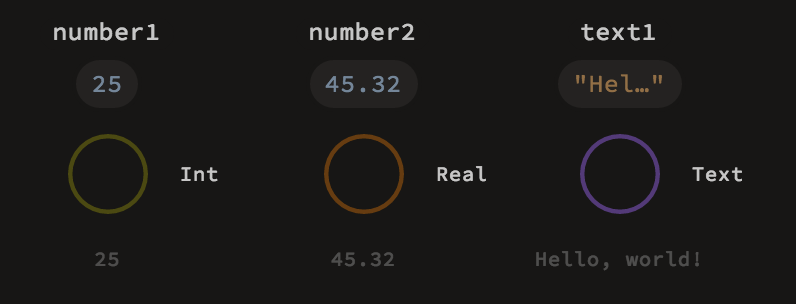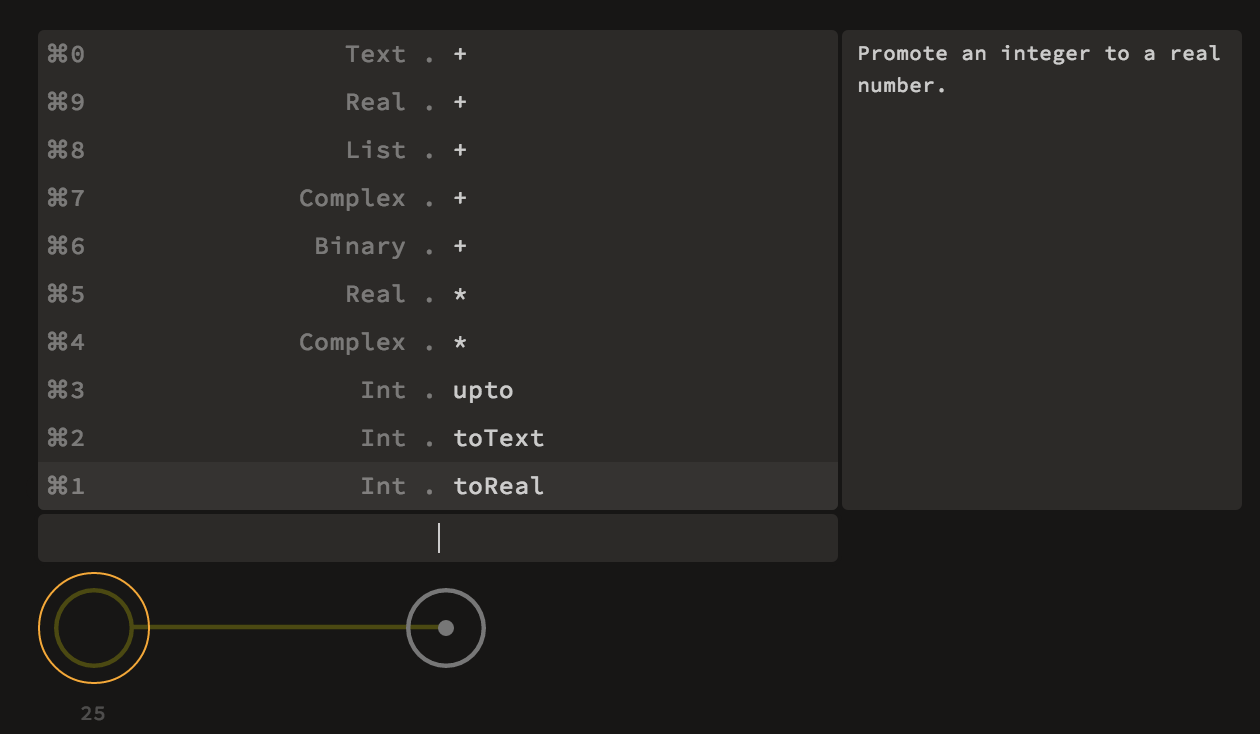Basic datatypes
In this section will go through the basic data types available in Luna. You'll encounter some of these in every Luna program.
Literal values
Luna supports three kinds of literals – expressions of special form, denoting primitive types of data. Those types are Text, Real and Int. Creating literal nodes is as simple as opening the Explorer and typing in the desired value. Ints are just numbers without a decimal point, Reals are those numbers that do contain a decimal point. Texts are arbitrary series of characters, delimited by quotes.

Remember that you can always press tab with a node of a specific type selected, to bring up the explorer and get a list of all operations supported by the type, together with their documentation.

Numeric types
The basic numeric types in Luna are Int, representing integers of arbitrary size and Real, for floating point numbers.
[info] Changes ahead!
Currently, the type of a numeric literal is decided based on the presence of decimal point. This means, that
1has the typeInt, while1.0has the typeReal. In the future releases of Luna, the numeric literals will be polymorphic, allowing to write expressions like1.7 + 2.
They support basic arithmetic operators and mathematical functions.
Text
The basic type for text processing in Luna is, unsurprisingly, Text. Luna supports two kinds of text literals: interpreted and uninterpreted. The interpreted texts are wrapped in single quotes. They provide the capabilities to insert escaped character sequences such as \n etc. The uninterpreted strings are wrapped in double quotes and do not provide any such facilities. The only character that can be escaped in an uninterpreted text is \" itself. It is usually sufficient and more handy to use single–quoted (interpreted) texts by default, unless you need to type in a text containing many special characters.
[info] Changes ahead!
In the future releases of Luna the interpreted texts will also allow to insert arbitrary expressions, results of which will be then inserted into the resulting text. For example
'Adding 2 and 2 gives `2 + 2` in result'will be evaluated to'Adding 2 and 2 gives 4 in result'.
Booleans
Logical values are represented using the Bool class. It has two constructors: True and False. They support basic logical combinators such as &&, || or not.
The most common function used for conditional branching in Luna is if_then_else. It can be used in this form (i.e. if_then_else condition valueWhenTrue valueWhenFalse) or, more elegantly, in its mixfix form:
if condition then valueWhenTrue else valueWhenFalse
There is nothing special about this function, all the arguments are standard values and it returns a value just like any other function would:
def reportRelationshipToSeven x:
relation = if x > 7 then "greater than" else "less than or equal to"
print (x.toText + " is " + relation + " seven")
Lists & Tuples
The most basic container types in Luna are tuples and lists.
Lists are arbitrary–length containers for same-type values. Some examples are [3, 4, 5] of type List Int or ['first', 'second', 'third'] of type List Text. There are also some interesting functions and methods in the standard library, that return lists of desired shape – make sure to go through the available methods using the Explorer. Some examples are:
1.upto 5 # => [1, 2, 3, 4, 5]
3.times "hello" # => ["hello", "hello", "hello"]
[True, False] . cycle . take 5 # => [True, False, True, False, True]
Tuples are like lists, but they can store elements of different types and they have statically defined lengths. Some examples are:
(1, "hello", False) :: (Int, Text, Bool)
("hi", 3.0) :: (Text, Real)
[info] Changes ahead!
In the future versions of Luna, lists and tuples will be merged into one type – a list which fully understands its structure and allows to encode information about its length and different element types on type level. Thus you may expect code like
["Hello", 32, False]to be valid Luna soon.
Maybe
Luna, much like other functional languages, does not have a null value. That means, if you have a value of type Int, there will always be a number, there is no way to have an "invalid" number. If there is a possibility of a value not being there, it needs to be encoded in a type-safe manner. This is where Maybe enters the stage. A value of class Maybe can either be Just value or None. You can check which of the possibilities happened using pattern matching. Suppose you have a value myNumber of type Maybe Int. You can use it like so:
reportedValue = case myNumber of
Just v -> 'Got a number ' + v.toText + '.'
Nothing -> 'Did not get a number.'
print reportedValue
There is also a bunch of useful methods like getWithDefault, which are handy to replace the pattern match in most cases. Consult Explorer for more details.